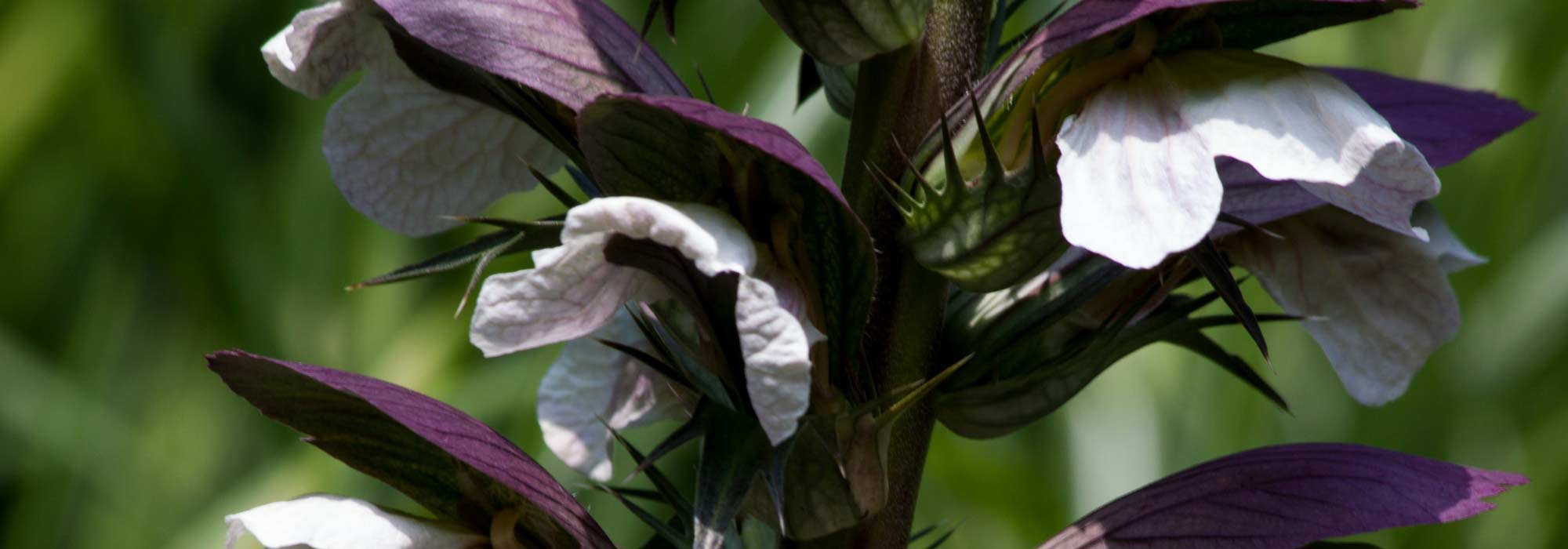
Acanthus: to plant, to grow and to maintain
Contents
Acanthus in a nutshell
- Acanthus is an easy and low-maintenance perennial that thrives in both sun and shade
- It is a highly architectural perennial with rapid growth
- It is very floriferous from June to September
- Vigorous, it can withstand temperatures down to -15°C
- It can reach a height of 1.5 m
A word from our expert
The Acanthus a majestic perennial that forms large clumps of deeply lobed large leaves, from which rise spectacular flower spikes throughout the summer. While acanthus leaves have adorned the Corinthian capitals of Greek temples since antiquity, it is in the garden that their highly structuring architecture is now appreciated.
From June to September, the flower stems dotted with flowers in white, green, yellow, pink, or purple and bristling with decorative thorns stand tall for some acanthus over 1.5 m above the ground and as wide, enhancing any perennial bed by adding a striking verticality.
Whether it is Soft-leaved Acanthus (Acanthus mollis) or Spiny Acanthus (Acanthus spinosus), the acanthus is a durable and vigorous giant, easy to grow in any rich, deep, and well-drained soil, whether in a bed, border, or as a specimen. The Acanthus makes lovely dry or fresh bouquets.
Its imposing lobed foliage and upright flower spikes will bring a very graphic and contemporary touch to the garden. Discover all our acanthus, from the most common to the most sought-after cultivars.
Botany
Botanical data
- Latin name Acanthus
- Family Acanthaceae
- Common name Acanthus
- Flowering from May to August
- Height 0.25 cm to 1.50 m
- Exposure Sun, partial shade
- Soil type All, well-drained
- Hardiness -15°C
Acanthus or Acanthus is a perennial plant from the Acanthaceae family, primarily native to the Mediterranean basin where it grows in dry, rocky places. The genus includes about thirty species with varying heights, but six species are endemic to Europe. The most common in our gardens are Acanthus mollis or the soft-leaved acanthus, with white flowers shaded with purple whose spikes can reach 1.50 m, and Acanthus spinosus or spiny acanthus with spiny foliage and white flowers with pink bracts that are also spiny.
There is also Acanthus hungaricus, smaller (80 cm), with its spineless leaves, which is the hardiest and most floriferous species of the genus. Acanthus hirsutus, with its semi-erect leaves, does not exceed 40 cm in height. Some hybrids like Acanthus ‘Whitewater’, are highly sought after for their variegated foliage.
Fast-growing, this suckering perennial spreads from a stump with large fleshy roots, quickly forming vast clumps over the years, which can sometimes become invasive. It can naturalise in gardens and will also self-seed spontaneously if it pleases. Its suckers are capable of drawing and storing water deep down during dry periods.
It is a plant with a majestic habit, bushy, dense, upright or semi-erect (A. hirsutus), more or less spreading, which can reach 1.80 m in height when flowering for Acanthus mollis, with a spread of 1.20 m. The Acanthus varies in size and shape from one species to another.
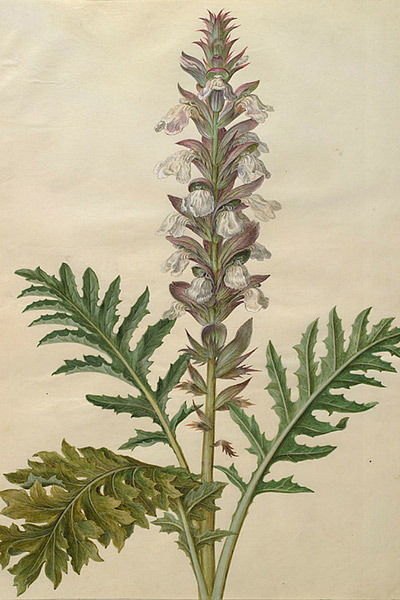
Acanthus mollis – Botanical illustration
The Acanthus is a large perennial grown for its deciduous or semi-persistent, highly graphic foliage whose sculpted pattern is found in the stone of Corinthian capitals since ancient Greek times.
In spring, the fleshy stump produces rosettes of leaves that form a large tuft emerging from the ground. They vary in size, shape, and number of lobes.
With spectacularly sized leaves, with a long petiole, ranging from 8 cm to 1 m in A. mollis and A. spinosus, shiny or pubescent, dark green sometimes marked with silver or variegated with cream white or golden yellow turning green as they age (Acanthus mollis ‘Hollards Gold’), appear. Oval and dentate, opposite and elongated, they are more or less deeply cut into spiny or non-spiny lobes depending on the species, up to the very marked midrib. The leaves of A. mollis have deeply cut shapes without true spines. The leaves of Acanthus spinosus have paler veins and almost white thorns. In Acanthus hungaricus, each lobe is narrowed at the base.
Some resemble dandelion leaves, others artichoke leaves. This foliage completely disappears after flowering but may reappear in autumn in mild climates. It is a perfect backdrop for its spectacular flowering in long spikes that continues throughout the summer.
From June to September, while the foliage tends to wither, large impressive spikes of flowers emerge, held 20 cm to 1.50 m above the foliage depending on the species. In some cultivars, the flower spikes take on a purplish pink colour.
Imperial, these upright spikes bear clusters of tubular flowers with two lips 3 to 6 cm long, well detached from the foliage, gathered in fours and arranged along robust stems. Watch your fingers, these flowers sting! Each flower is topped with pubescent bracts that are often spiny. Shaded in purple, violet, pink, or more rarely yellowish green, these caps give a bicoloured aspect to this white, cream with pink reflections, green, yellow, pink, or purple flowering.

Hungarian Acanthus, Acanthus hungaricus
Not fragrant, they are however melliferous and attract pollinating insects. This flowering lasts for weeks.
The flowers of the Acanthus allow for creating beautiful fresh summer bouquets. The dried inflorescences are very graphic in a vase.
The floral corollas give way after flowering to small shiny capsules that contain four large seeds. The cap remains during the fruit formation and turns dark brown.
Hardy, the Acanthus is a vigorous plant that withstands temperatures down to -15°C. Some, like Acanthus spinosus, are more tender. However, all are easy to grow in dry soils and in the sun.
The Acanthus grows quickly in any soil, fairly rich, deep, and well-drained that remains cool in autumn and spring. It only fears winter moisture. It will adapt even in calcareous, stony soil and dry in summer. Some even grow in scree.
From its Mediterranean origins, it has retained a good drought resistance. It enjoys full sun where it flowers profusely but will prefer partial or shaded exposures in very hot climates. It does not like to be moved, as once well established it develops an extremely long and running root.
The Acanthus is a beautiful architectural perennial with antique charm that is always very noticeable in a garden. It is highly valued for structuring prairie-style gardens as it adds verticality and volume to clumps of perennial plants or colourful annuals. It is also precious when grown alone to introduce vertical accents and light focal points in the back of borders, in edges, or why not in pots near the house.
Species and main varieties
There are about thirty species of Acanthus, but only a few are cultivated, still offering a beautiful choice of flower and foliage colours. All are hardy and form robust, dense clumps that are very ornamental.
The most well-known and widespread in our gardens is the imposing Soft-leaved Acanthus (Acanthus mollis) with its purplish white flowers and large, deeply lobed, non-thorny leaves that can reach up to 1 metre in length; it is also the largest, with flower spikes that can reach up to 2 metres in height.
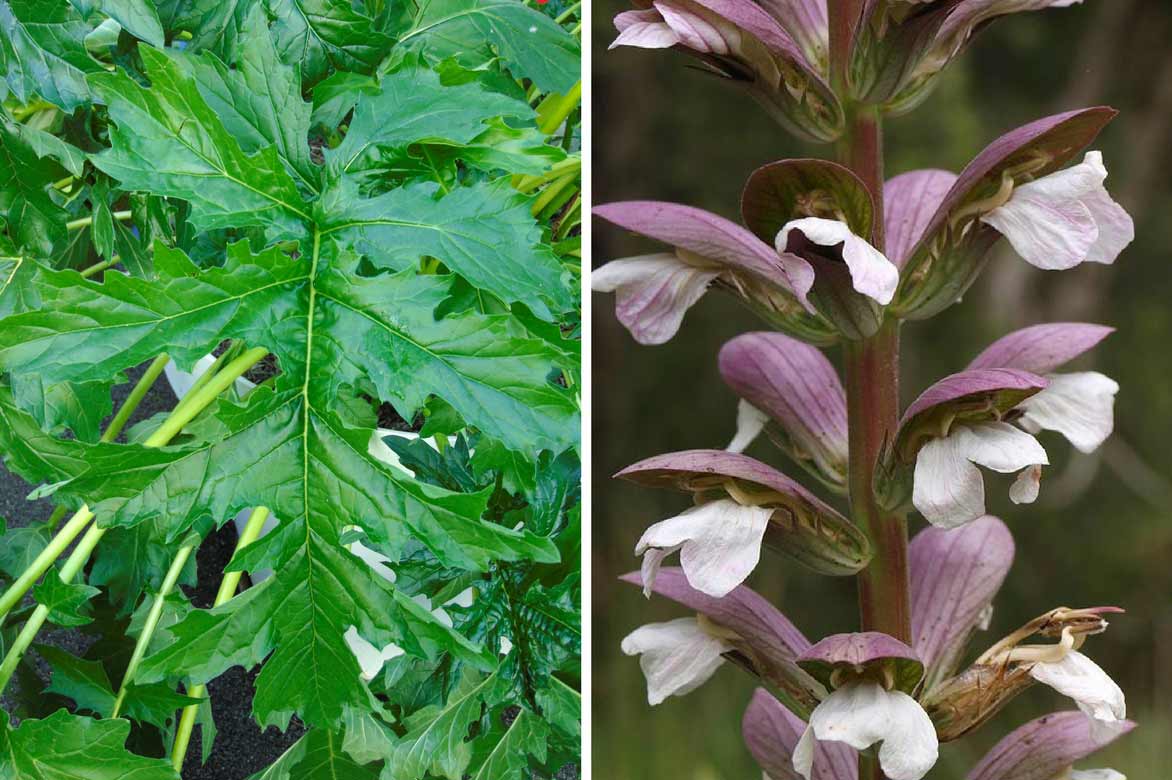
Foliage and flowering of Acanthus mollis
It has given rise to Acanthus mollis ‘Rue Ledan’ (Jeff Albus), a variety that is distinguished mainly by the white colour of its flowers covered by a greenish hood. The cultivar ‘Hollards Gold’ develops golden yellow leaves that turn green in summer, while Acanthus ‘Whitewater’ offers a very decorative variegated white foliage.
Also frequently found is Acanthus spinosus, which forms a beautiful clump with thorny foliage that is deeply lobed and charming; it is more invasive than A. mollis. It is more often used as ground cover to cover difficult slopes. Acanthus hirsutus is the smallest and does not exceed 40 cm in height at maturity.

Acanthus spinosus – flowering and foliage
Acanthus hungaricus, also known as Hungarian Acanthus or Balkan Acanthus, is smaller but is the most floriferous and vigorous of all the acanthuses. Its leaves are non-thorny and narrower than those of Soft-leaved Acanthus.
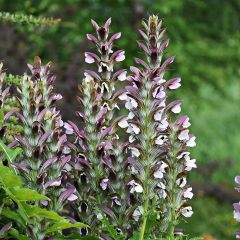
Acanthus mollis - Bear's Breech
- Flowering time July to September
- Height at maturity 1,50 m
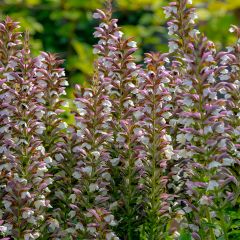
Acanthus spinosus - Bear's Breech
- Flowering time July to September
- Height at maturity 1 m
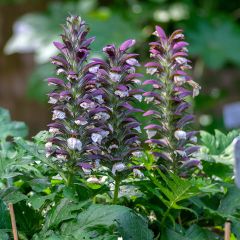
Acanthus hungaricus
- Flowering time July, August
- Height at maturity 80 cm
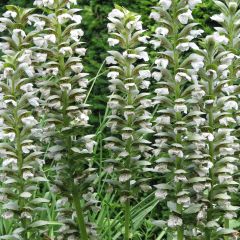
Acanthus mollis Rue Ledan - Bear's Breech
- Flowering time July, August
- Height at maturity 1,20 m
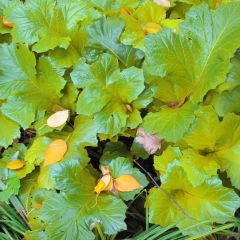
Acanthus mollis Hollards Gold - Bear's Breech
- Flowering time July to September
- Height at maturity 80 cm
Discover other Acanthus
View all →
Available in 3 sizes
Available in 3 sizes
Available in 1 sizes
Available in 1 sizes
Available in 1 sizes
Available in 1 sizes
Available in 1 sizes
Available in 1 sizes
Available in 2 sizes
Available in 1 sizes
Young plantation
Where to plant the Acanthus?
The Acanthus thrives easily in full sun where it will grow larger and more floriferous, but it can tolerate light shade during the hottest hours in regions south of the Loire. This cold-resistant perennial can be planted anywhere in France. Most are vigorous and can withstand, albeit for short periods, temperatures down to -15°C; however, some species may be more frost-sensitive.
While it grows in any type of soil, provided it is very well-drained, even dry or stony and cool in summer, it does prefer rich, deep soils. It only fears wet and waterlogged soils in winter. In heavy, damp soil, it will struggle and may die or grow very slowly. Ensure to place it in a dry spot, in an area without excess water in winter. On the other hand, this Mediterranean plant tolerates summer drought well.
The Acanthus is a plant that enjoys its peace and hates being moved, so choose carefully where you will plant it and allow enough space for it to grow.
Very graphic, it is ideal for adding verticality and volume to perennial plant beds. It fits into all settings, borders or edges but truly shines as a background or mid-border plant. The spiny Acanthus or A. spinosus will form a robust ground cover on difficult slopes. Others will create a spectacular focal point in a large perennial bed, standing alone on a lawn, or planted in groups at the edge of a thicket.
Large species need plenty of space as they tend to overshadow fragile plants around them. They prefer to be placed in a sunny spot, sheltered from strong winds and well-exposed, which will encourage the plant to reach its full height. They are planted at the back of beds, providing relief and striking verticality.
Pot cultivation is not recommended for these plants that prefer coolness and deep soil, but it is possible with some precautions. More than in open ground, the potted Acanthus requires fertiliser and sunlight, in a container at least 30 cm deep with a potting mix enriched with good compost or well-decomposed manure.
The Acanthus is a suckering plant, it naturalises easily where it is happy, in full sun, partial shade or even in the shade.
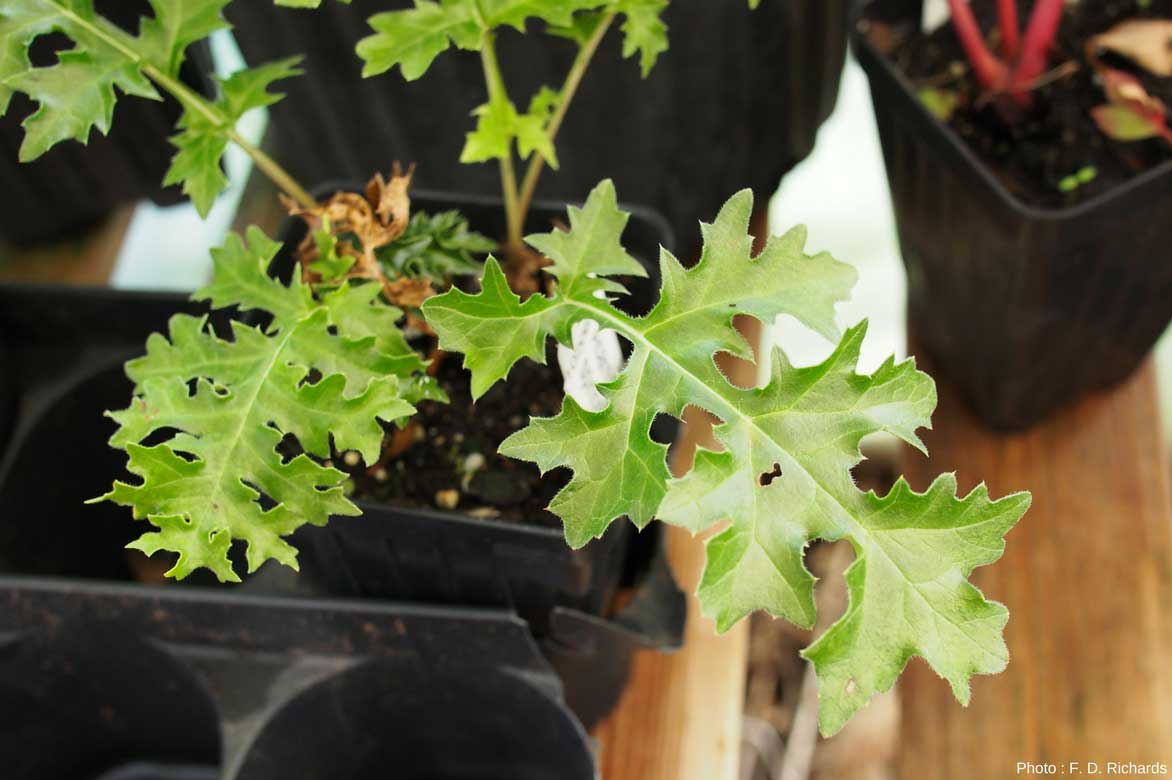
When to plant?
Ideally in spring, in April or May, depending on the region, when all risk of frost has passed. Planting in autumn is also possible to encourage rooting before winter.
How to plant Acanthuses?
Plant in deep, cool soil, without excess lime, rich and well-drained. Be careful, this plant has thorns; the edges of the leaves often bear formidable needles capable of causing injury.
In heavy, clayey soil, add potting mix and compost at planting, lightening it with river sand or pumice to avoid the excess moisture feared by the Acanthus. Maintain a distance of about 60-80 cm between each plant to allow for proper growth.
- Keep the root ball intact, as the Acanthus root hates being disturbed
- Dig a hole 3 to 5 times wider than the root ball and deep
- Bring the soil back to encircle the roots and firm it down
- Water thoroughly until it takes
- Protect the plant from slugs
- Mulch especially during the first winter following planting to allow for better establishment, keep the soil cool in summer, and protect from late frosts
- During growth, water moderately; the soil should remain cool in summer but never waterlogged
- Apply liquid fertiliser once a month
Note: in summer, the plant enters dormancy and its foliage yellows; it is then unnecessary to water excessively, as the plant follows its normal vegetative cycle and ‘sleeps’ to protect itself from drought.
Maintenance, pruning and care
Once well established, the Acanthus requires no special care. It does not need watering except in cases of prolonged drought.
After flowering and before fruiting, cut back the flower stems if you do not want it to self-seed spontaneously, or leave them to set seed to benefit from spontaneous sowing, then cut back the faded foliage as short as possible in autumn.
While it is hardy, it will struggle with intense cold, especially in cases of prolonged and deep frost. You can leave the foliage once cut on site; it will provide a natural mulch during very cold weather to prevent any risk of frost. Repeat the operation in summer with a mulch of dried leaves, for example, to maintain some moisture in the soil.
In summer, during dormancy, reduce watering, the foliage disappears during high heat, but it will regrow from the stump in autumn.
Diseases and potential pests
The Acanthus has two known enemies:
- slugs and snails that devour the young shoots before they even emerge from the ground in spring. Mechanical traps or a slug treatment, applied at planting, followed by annual applications starting in February, is essential.
- powdery mildew, a characteristic that leaves a white fluff on the leaves. Spray with nettle and horsetail manure as a preventive measure if necessary.
Multiplication
At home in your garden, the Acanthus will self-seed readily. However, it propagates quite easily by sowing seeds or by propagation by cuttings of the roots. We do not recommend dividing the clumps, as it is too risky, since the Acanthus dislikes being disturbed.
By sowing
You can sow directly in the ground or under a cold frame in March, using seeds harvested at ripeness in autumn before the capsules burst and release their contents. When propagating Acanthus, the first flowers will only appear after 2-3 years. Sowing rarely produces plants true to the parent.
- In the ground
Thin the plants as they begin to develop.
- In a greenhouse
Sow in spring on compost, barely covering them with potting soil kept moist. Germination takes one to four weeks. Transplant the seedlings as soon as the first leaves appear, directly into their final position.
→ Learn more with our tutorial; How to harvest and sow Acanthus seeds?
By propagation by cuttings of the roots
Propagation by cuttings guarantees robust plants that are true to colour to the parent. This is done on plants aged 3 or 4 years.
- In autumn or late winter, gently extract the roots with a fork
- Cut them into sections of 5 to 8 cm
- Insert them horizontally into buckets containing a light, well-draining mix of sandy compost, just covering them
- Maintain at 15 to 20 °C and water regularly
- Root formation takes four to five weeks
- Transplant into pots or plant directly in the ground
→ Learn more in our tutorial: How to propagate Acanthus?
Associate
Acanthus is a striking perennial that adds an architectural touch highly sought after in gardens. With its very graphic habit, it brings panache, volume, and verticality to perennial or annual borders.
A reliable choice for herbaceous borders, it is appreciated for its impressive clusters of flowers in white, pink, or yellow. It pairs well with the pink-mauve flowers of lavateras, while varieties with purple flowers will create contrasts with the yellow blooms of a golden chamomile or the green-yellow inflorescences of alchemilla.
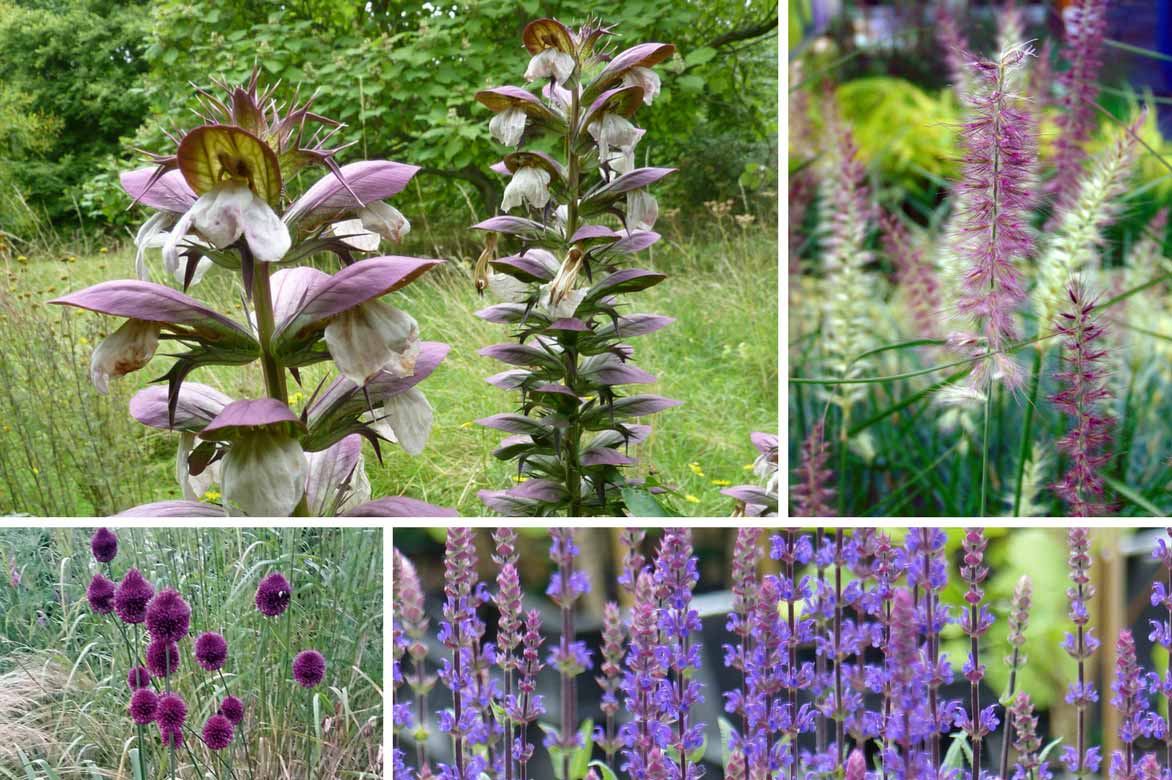
In a natural garden, pair Acanthus spinosus with Pennisetum orientale ‘Karley Rose’, Allium sphaerocephalon, and Salvia nemorosa ‘Caradonna’
It generally blooms during the rose season, at the end of spring and the beginning of summer, making it an excellent companion for old or perpetual white or yellow roses, with which it creates charming and romantic scenes, as well as for a multitude of sun-loving perennials like itself.
It fits into all settings, and with its ample and generous foliage featuring deep cuts, it can serve as a stunning focal plant at the back of a border or as a flower for flowerbeds.
Its tall structural silhouette adds breath to a meadow-style garden as well as to natural scenes at the edge of woodlands or to more contemporary displays.
It is also a beautiful must-have for white gardens, where it will thrive alongside a white-flowered rose, ‘Echinacea ‘Meringue’, and Digitalis ‘Snow Thimble’ or Epilobium angustifolium album.
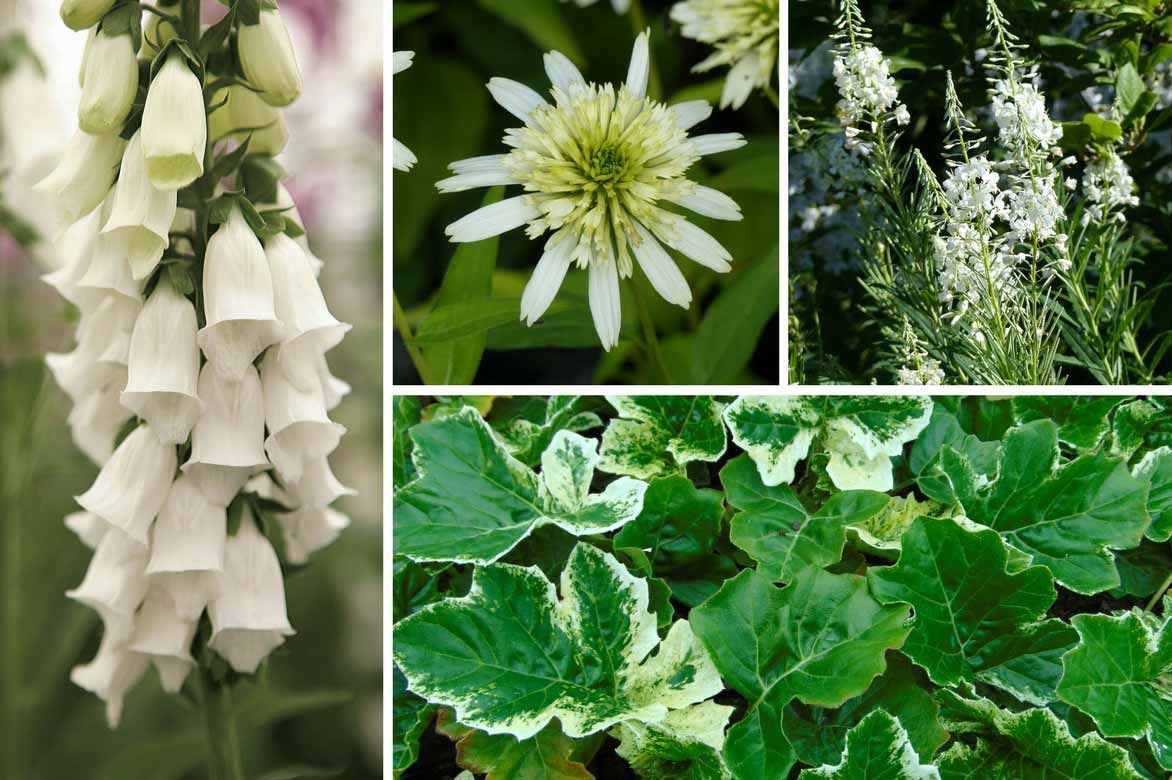
Digitalis ‘Snow Thimble’, Echinacea purpurea ‘Meringue’, Epilobium angustifolium album, and the variegated foliage of Acanthus ‘Whitewater’
It combines beautifully in opulent summer scenes that are quite exotic with echinaceas, giant eryngiums, Cimicifuga Racemosa, Kniphofia, or giant dahlias. Its spectacular foliage and summer flower spikes pair well with Oriental poppies.
In a dry garden, it will add flair alongside Achilleas, Agastaches, Wormwoods, a Ceratostigma griffithii, or euphorbias.
The plant pairs very well with softer foliage plants like grasses, with which it will create a lovely contrast in shape.
→ Discover more association ideas with Acanthus in Gwenaëlle’s advice sheet.
Useful resources
- A wealth of ideas for creating beautiful summer borders, to read on our blog
- Our advice sheets on the Acanthus:
- 6 varieties of Acanthus to grow in the garden;
- Acanthus: the most beautiful varieties to discover;
- Pairing Acanthus;
- How to get rid of an invasive Acanthus?
- Growing Acanthus in pots
- Diseases and pests of Acanthus
- Subscribe!
- Contents
































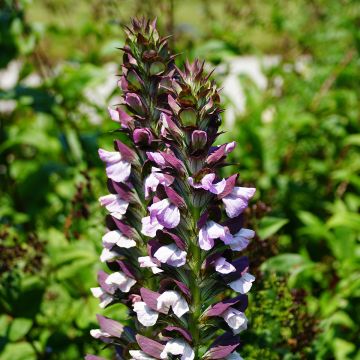
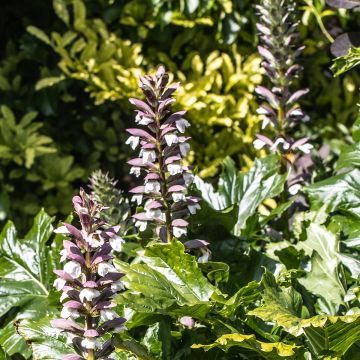
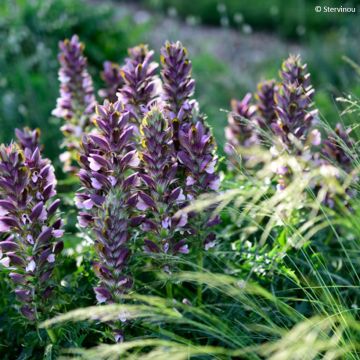
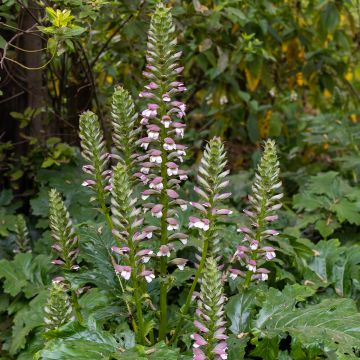




Comments